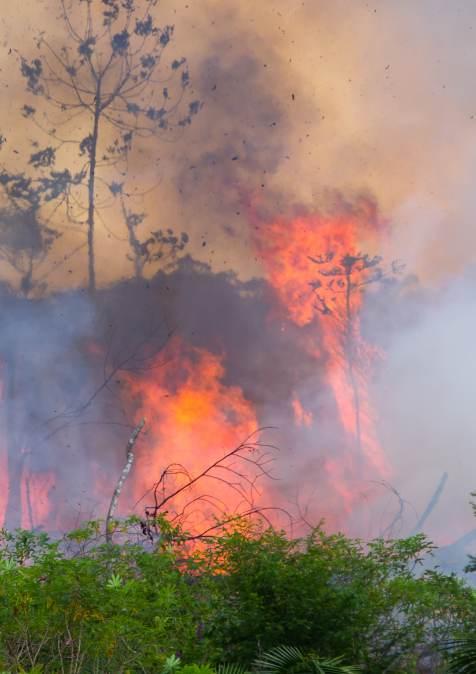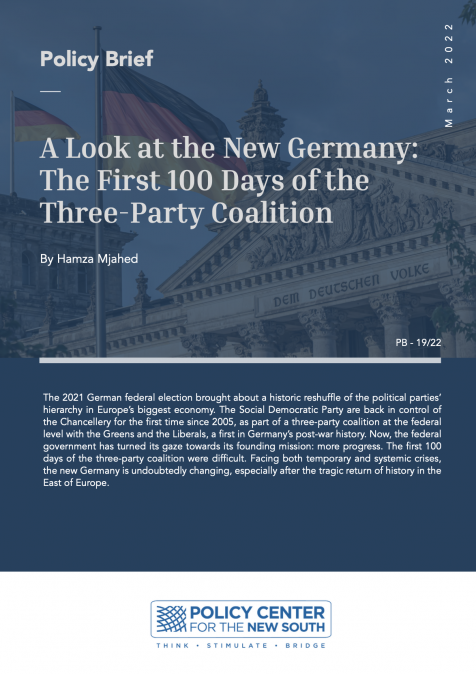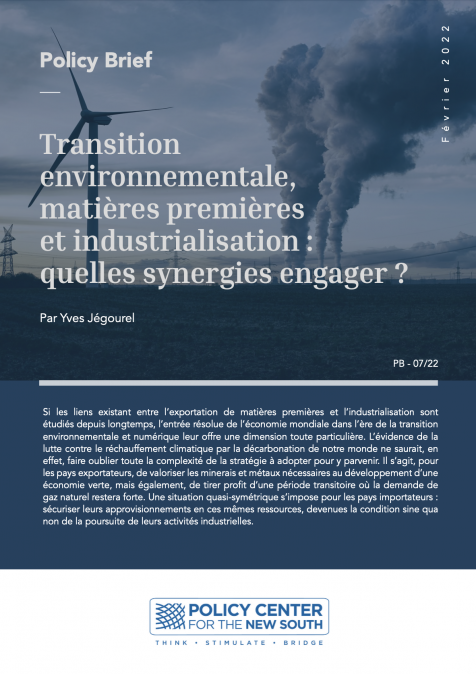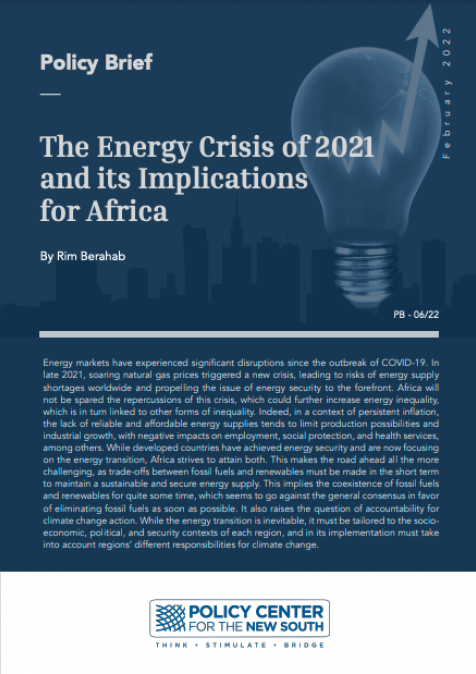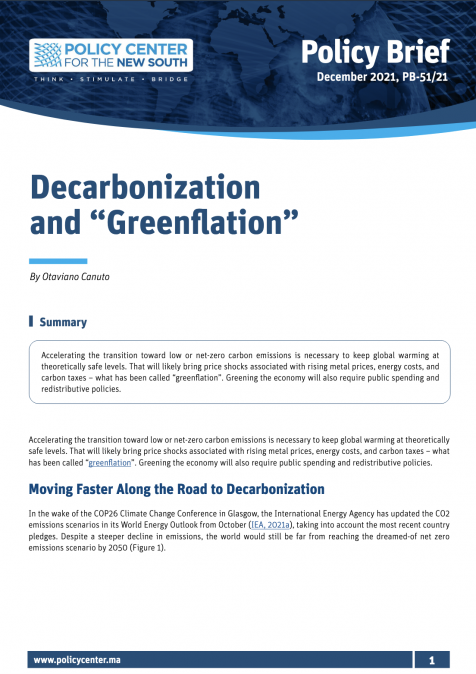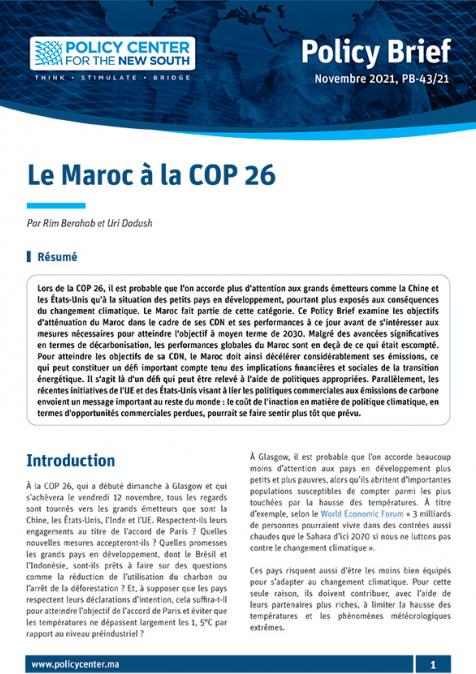Publications /
Opinion
This brief was originally published on gmfus.org as part of a partnership between the Policy Center for the New South and the German Marshall Fund of the United States.
Air and ocean temperatures are increasing at record levels despite international efforts to mitigate carbon emissions.
The consequences of this failure go beyond its harmful effects on climate patterns to endangering global political, economic, and social stability. Human security is on the line and faces even greater threat unless more and stronger measures are undertaken to cool and adapt to an ever-warming planet.
Today’s world, especially vast regions of Africa, Central America, the Caribbean and Asia, is confronting more recurrent droughts, increasing desertification, agricultural land degradation, and mounting pressure on water and land management. These effects of climate change already impact food security and generate climate migrants seeking food, shelter, and safer places to live. Rising sea levels have displaced coastal populations as polar ice caps melt.
Governments are overwhelmed. They strain to deal with wildfires, floods, and ever more destructive hurricanes, losing confidence and trust as they fail in these increasingly complex and expensive endeavors. The repercussions are potentially existential, as assessments from national security agencies confirm. Unsurprisingly, “climate security” is an issue of growing international concern.
The prospects for climate-vulnerable countries and regions are likely to worsen. Political, economic, and social instability and an increased need for humanitarian assistance, particularly after 2030, are likely to converge. Six out of the top ten risks noted in the World Economic Forum’s 2023 Global Risks Report are related to climate and the environment and may emerge as a result of a failure to mitigate and adapt to climate change, natural disasters, extreme weather events, and natural resources crises, such as water and food shortages. The US National Security Strategy predicts that climate change will increase the need for disaster response by civil authorities, strain governance capacity, affect security relationships, and raise international tensions, risking new armed conflicts.
The outlook may be bleak, but adaptation through incremental and transformational measures can significantly reduce the effects of climate change. Unfortunately, adapting to a warmer planet garners insufficient attention. The emphasis instead has been on mitigation, which by itself is inadequate. Even the international climate agenda focuses on reducing carbon emissions to meet the Paris Agreement goal of holding “the increase in the global average temperature to well below 2°C above pre-industrial levels” and pursuing efforts “to limit the temperature increase to 1.5°C above pre-industrial levels”.
A more balanced combination of mitigation and adaptation measures is urgently needed, and the transatlantic partners can make significant contributions to attaining this balance by expanding their adaptation efforts, forging deeper ties with the Global South, and complementing these steps with maintaining current efforts to cut carbon emissions. Doing so would help lay the foundation for preparing for the global upheaval that climate change is likely to bring.
A Vicious Cycle
Climate-induced instability impacts an increasing number of fragile countries, especially those experiencing conflict. Of 12 countries with UN peace operations and missions, 10 are among the most climate vulnerable. This is not a coincidence. Evidence that climate change exacerbates conflict has long existed.
Droughts, for example, lead to food insecurity and, in turn, social unrest. That, combined with a governmental inability to provide essential services, contributes to conditions that beget militant groups. The Sahel and the Horn of Africa are conflict-plagued because they face intense droughts and, consequently, hunger, forced migration, and social turmoil. The UN Intergovernmental Panel on Climate Change projects that severe drought will displace 700 million people in Africa alone, most internally, by 2030. The chain of events is unsurprising. Fully 90% of the world’s refugees originate from countries most impacted by climate change but with little capacity to adapt to an increasingly hostile physical environment.
Climate-related devastation contributes to increasing competition for and weaponizing of ever-scarcer water, land, and rare-earth minerals, and the degradation, deforestation, and desertification of fertile land. It is a vicious cycle. Droughts have increased by 29% since 2000 and have become more intense, putting additional pressure on climate-sensitive livelihoods, such as farming. Droughts already affect 55 million people and have national and continental repercussions. Argentina, a top food producer, is expected to see agricultural exports drop 15% in 2023 due to severe drought. Africa, whose population is expected to nearly triple to 2.5 billion by 2050, may well see climate change produce unprecedented levels of food insecurity.
Stepping Up Efforts
Fortunately, measures are underway to address the growing challenges. The UN’s 2018 Climate Security Mechanism, which offers expertise, funding, and programming, is the most significant multilateral effort to systematically address the adverse impacts of climate change on peace and security. Another effort is the International Drought Resilience Alliance, created in September 2022, which aims to help vulnerable countries prepare for drought. This initiative, led by Spain and Senegal, has the support of more than 50 nations and organizations, including the United States, the EU, Germany, France, and Italy, among other Atlantic partners. In Africa, regional projects, such as the Great Green Wall, launched by the African Union in 2007, attempt to stop an advancing Sahara by restoring 100 million hectares of degraded land, sequester 250 million tons of carbon, and create 10 million green jobs by 2030. Other key multilateral organizations, such as the World Bank, the Economic Community of West African States (ECOWAS), and the Organization for Security and Co-operation in Europe (OSCE), are incorporating climate security considerations into their thinking and planning.
Individual nations and blocs of states are also taking measures. The latest US National Security Strategy prioritizes climate and energy security while the Department of Defense integrates these concerns into risk analyses, strategy development, planning, modeling, simulation, and war gaming. The President’s Emergency Plan for Adaptation and Resilience, PREPARE, launched in 2021, and its Action Plan, launched in 2022, are bold and well-conceived steps that give climate adaptation measures an important presidential imprimatur. The EU is ensuring that climate considerations are built into external policies and programs through its Concept for an Integrated Approach on Climate Change and Security. And NATO also sees the need for action. At its June 2022 summit in Madrid, the alliance included climate-related risks as an integral part of its Strategic Concept and overarching approach to security. Several months later, at the Berlin Climate and Security Conference, G7 countries and the EU jointly launched their Climate, Environment, Peace and Security Initiative to tackle environmental risks to international peace and stability. Countries such as Germany, Finland, Ireland, Luxembourg, the Netherlands, Norway, Spain, and Sweden are pushing for additional national climate, peace, and security initiatives. Climate security is one of Switzerland’s four thematic priorities during its first-ever term on the UN Security Council in 2023-2024.
Research institutions and think tanks are also highlighting the links between environmental well-being and international security. They have begun collaborating with innovative, multistakeholder initiatives, such as Weathering Risks and the Water, Peace and Security Partnership, to improve understanding of climate-security risks through scenarios, modelling, and machine learning. Their ultimate goal is to expand the number of tools available to deal with emerging climate crises.
Getting Everyone on Board
Despite the rising attention given to climate security, two recent efforts to reach consensus on the implications of climate change reflect the insufficient progress to confront it. This underscores the need for more international action.
The first effort failed in the UN Security Council. Niger and Ireland presented in December 2021 a draft resolution on climate and security sponsored by 113 countries, the second-largest number to support a resolution since the UN’s founding in 1945. Although 12 of the council’s 15 nations voted in favor, a Russian veto doomed the resolution. Moscow felt that it distracted from the real root cause of conflicts, which is not climate related. India also voted against it while China abstained.
The second effort came at the COP27 conference in November 2022. Representatives did approve creating a historic Loss and Damage Fund to compensate vulnerable countries hit by climate disasters, but the good news ends there. Global political polarization held debates hostage, producing no further accomplishments, while many developing and oil-producing countries focused solely on the fund to the detriment of all other issues. The latter were unwilling to discuss emissions reductions and other mitigating measures. Even the conference’s closing statement, known as the “Decision”, makes almost no reference to the consequences of climate change for human security. The word “security” itself is mentioned only twice in the context of food security.
No Time to Waste
Beyond the current difficulties of consensus building lies a bleak future for tackling climate security challenges. Global insecurity from a warming planet is likely to worsen in the coming years. Responding to this challenge requires urgent national, regional, and worldwide climate adaptation action that can complement carbon emissions mitigation efforts. Climate security-sensitive programs are instrumental for this but need more political support before severe security, energy, and other crises monopolize global attention and jeopardize previous environmental advances. A world too busy putting out fires will lack the resources to provide more climate security.
Strengthened transatlantic leadership in this area can be a game changer, and Europe and the United States should start exerting their influence by building bridges with countries of the Global South with approaches that address their ethical, economic, and strategic concerns. Recognition of the multiple climate-security crises these countries face, whether related to energy, food, or health, and a sincere willingness to tackle these challenges, would solidify the transatlantic partnership’s influence on issues that will shape the globe in the coming decades. It could also spur development of unified transatlantic policies in these areas, thereby strengthening the partnership itself and its ability to confront climate-security challenges.
Seven measures to further climate adaption are:
- integrating climate concerns into the implementation of stabilization, peacebuilding, mediation, development, and humanitarian projects. This would better enable targeted action, particularly in the most climate-vulnerable countries.
- exchanging international experience and expertise in natural-resource management, particularly that concerning water and land.
- committing to the UN Secretary General’s proposal to develop a New Agenda for Peace that includes prioritizing climate-security risk management ahead of the 2024 Summit of the Future.
- outlining guidelines and better practices to boost local government and community involvement in decision-making and project implementation processes, and prioritizing gender issues on climate and migration policy as most persons displaced are women and girls.
- better assessing the impact of climate change, improving early warning systems, and sharing satellite analysis and meteorological forecasts for early and preventive action at the local, national, and regional levels. This can be done by implementing the Sendai Framework for Disaster Risk Reduction (2015-2030), which underwent midterm review in May 2023, focusing on prevention.
- being inclusive by engaging the expertise of civil society organizations, universities, foundations, the private sector, and think tanks to implement climate-adaptation measures.
- increasing targeted funding to build climate-resilient communities, infrastructure, and livelihoods in the most vulnerable locations. The creation of the Loss and Damage Fund offers a unique opportunity to consider climate security in financing. Greater commitment from transatlantic partners at COP28 and beyond would provide another opportunity to anchor climate security and adaptation measures in the programs the fund will cover.
Walking the talk requires leading by example. It is the only way to make progress on common goals. The measures outlined above are possible and practical and will lead to safe and humane policies needed for building climate security and adapting to a warming planet.

